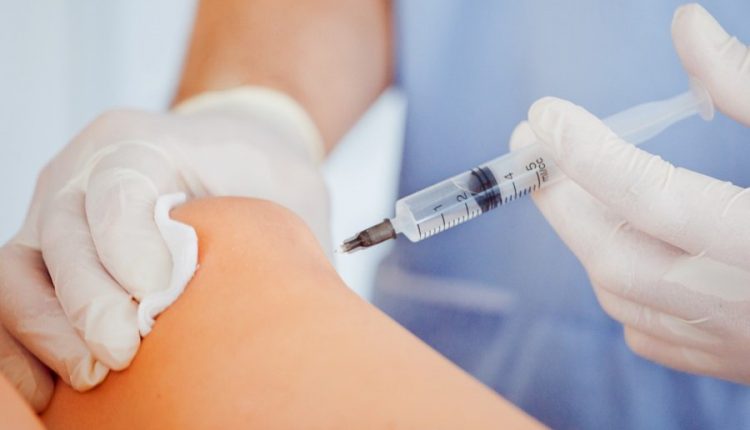
Juvenile Idiopathic Arthritis, Intra-articular Injections: Glucocorticoids
Intra-articular injections are used to treat inflammatory processes affecting the joints. To limit pain they are always performed under sedation
Intra-articular injections are performed at the joint level, in the parts that may be affected by inflammatory processes
They are particularly used in persistent arthritis and in children, typically in juvenile idiopathic arthritis (JIA), either as treatment of a few inflamed sites or as a supplement to general therapy.
The procedure is always performed under sedation in young children and also in older children or adolescents, when many joints need to be infiltrated in the same session.
Sedation is preferred in order to limit the experience of pain caused by the procedure and to avoid any spontaneous movements that may cause pain during the procedure or make it difficult to perform.
When only one joint needs to be infiltrated and there is full cooperation from the child, the procedure can be performed under local anaesthesia with the support of the parents.
Technically, the part to be infiltrated is carefully disinfected and placed on a sterile drape; with ultrasound guidance during or immediately before the infiltration, the point of entry is identified, and the route to be taken by the infiltration needle, in order to reach exactly the desired point to aspirate any inflammatory fluid and then to inject the drug.
Once the drug has been administered, the needle is removed by exerting a small amount of local compression with a sterile pad, which will be maintained with a local compressive dressing.
Sometimes a few drops of anaesthetic may be injected during removal of the needle.
An ice pack is then applied locally for 10-15 minutes, about every 2 hours for the next 6-8 hours.
The infiltrated sites are kept unloaded for 24 hours (e.g. no walking if a knee has been injected), without, however, going as far as immobilisation.
CHILD HEALTH: LEARN MORE ABOUT MEDICHILD BY VISITING THE BOOTH AT EMERGENCY EXPO
Intra-articular injections in paediatric rheumatology
In paediatric rheumatology, for the treatment of juvenile idiopathic arthritis or persistent arthritis associated with other inflammatory clinical pictures, slow-release corticosteroids (glucocorticoids in scientific terms) should be used (e.g. Triamcinolone hexacetonide), so that their potent anti-inflammatory effect persists for a prolonged time and reduces the need to repeat the procedure frequently.
Moreover, the compounds used have a very low absorption in the blood, so the side effects typical of oral or intravenous treatment are practically absent.
Intra-articular injections can lead to complications, although not frequently
The most frequent and most immediate complication is greater-than-expected procedural pain in patients in whom the procedure is not performed under sedation: it can be controlled with relaxation techniques during the procedure, with the administration of a limited amount of anaesthetic after the injection of the drug, and with the local application of an ice pack; if necessary, a general painkiller (e.g. paracetamol) can be administered.
Rarely, due to reflux of cortisone from the infiltrated site to the skin surface, a discolouration (hypopigmentation) or thinning (atrophy) of the skin may appear after a few months; generally, these are only blemishes that fade over time.
To reduce the risk of hypopigmentation and atrophy, it is important to maintain an adequate compression dressing in the hours following the injection and to avoid exertion or weight bearing on the infiltrated joints in the 24-48 hours following the injection.
With proper observance of hygiene and asepsis rules (thorough cleansing of the child, disinfection of the skin at the site to be infiltrated, hand washing and use of sterile material), the risk of joint infection due to the procedure is in fact exceptional: it manifests itself with pain that progressively worsens, limitation of joint movement associated with local heat and possible rise in body temperature up to real fever (axillary temperature above 38°C).
Intra-articular glucocorticoid injections may also be repeated at the same site at least two months apart
Unless an infection is suspected in the days immediately following the infiltration, it is not necessary to perform checks in the short term.
For the control of the overall joint symptomatology it is useful to continue periodic clinical and ultrasound checks.
Read Also:
Emergency Live Even More…Live: Download The New Free App Of Your Newspaper For IOS And Android
Arthrosis: What It Is And How To Treat It
Rheumatoid Arthritis: Staging, Course And Treatment
Juvenile Idiopathic Arthritis: Study Of Oral Therapy With Tofacitinib By Gaslini Of Genoa
Rheumatic Diseases: Arthritis And Arthrosis, What Are The Differences?
Rheumatoid Arthritis: Symptoms, Diagnosis And Treatment
Low-Fat Vegan Diet May Bring Relief From Rheumatoid Arthritis
Bone Callus And Pseudoarthrosis, When The Fracture Does Not Heal: Causes, Diagnosis And Treatment
Septic Arthritis: What Is It, What Causes It And What Are The Treatments
Rheumatoid Arthritis: Initial Symptoms, Causes, Treatment And Mortality



